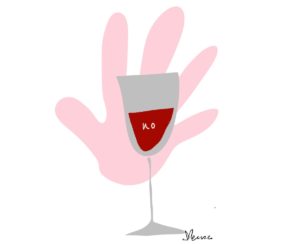
Yes is welcoming. Yes is affirming. In negotiations, yes is the thing we strive to get to. Sell wine in a retail venue and you quickly learn that frequent , enthusiastic applications of yes! is veryt sound policy indeed.
But, from time to time, a forthright no is what’s really called for — especially when it’s a matter of sorting out fact from fiction in wine, where (we blush to admit) a shocking amount of misinformation is allowed to run off the leash. We can’t hope to deal with the whole mischievous pack of ’em in this small space, but we’ll have a go at putting the kibosh on at least a few stubborn fallacies. Bear with us while we pop some bibulous balloons.
Older Vines make better wines, right? Well . . . young vines have less well-developed root systems and, compared with older vines of the same variety, produce fruit that is less rich in phenolic compounds (the stuff that makes wine winey). But this really only says that a young vine will make a different kind of wine than an older counterpart. It’s up to you to decide which is better (i.e. which you prefer). It’s worth noting that the 1973 Stag’s Leap Napa Cabernet that bested France’s 1970 Château Mouton Rothschild and Château Haut Brion in the famous Judgment of Paris tasting of 1976, and put California wine on the map, was made from vines scarcely three years old. So, young can be good.
Appellation-designated wines (Côtes du Rhone, Chianti Classico, etc.) are always a step up from basic table wine, right? Well . . . while appellation rules establish standards of practice aimed at enforcing a consensus style, we see a surprising number of conscientious-types opting out of the system in order to make highER quality wines with, for example, non-authorized grape varietals or experimental techniques. This kind of wine can be every bit as good as — often better than — more conformist examples. This is one of those moments when the reputation of the winemaker or property isn’t just everything … it’s EVERYTHING.
Natural wines are sulfite-free, right? Well . . . sulfur compounds are a natural product of fermentation and as such are present in all wine to some degree. The question is really how much is added in the winemaking process.
Vintners who operate within a naturalist aesthetic would like the answer to be zero, and work toward that as a goal. In practice, they can’t always live up to this standard. Some few manage to avoid all use of S02, except for a tiny bit at bottling, to keep the wine stable; others have been at this quite challenging task for so long that they can do without even this little bit. FKC Huron shelves have many low and no sulfites-added wine. Just ask.
You have to be very careful buying rosé because so much of it is sweet. Well . . . not here. We can’t vouch for the most commercial sort of rubbishy pink wine, but traditional European rosé of the kind that fascinates us has always been fermented to a dryness equal to that of red and white wines. If you’re old enough to remember the bad old days of sickly sweet White Zinfandel (O tempora, o mores! ), then you’re old enough to understand the meaning of the phrase historical aberration.
Chardonnay is always oaky and lactic, right? Well . . . Chardonnay is a widely-planted white grape which can be, and is, made in a bewildering variety of styles, ranging from something resembling buttered popcorn to crunchy, cool-as-a-cucumber types. Climate and winemaking approach determine how it turns out. Thank you for not holding innocent grape varieties responsible for the indignities to which they are subjected.
Your author is always right, right? If only it were so, Dear Reader